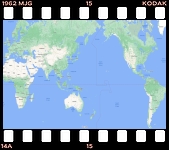Once inside Honduras I found a local bus that got me as far as the town of Choculteca. I agonised with the fact that my natural route wasn’t going to take me to the Honduran capital Tegucigalpa unless I doubled back to the north again. It seemed a little unsatisfactory to visit a small country and not go the capital. However I was running out of days if I wanted to see much of the final 3 countries in Central America, and have a full 3 months in South America. And in any case I wasn’t going to be able to visit the capital of every country I went to.

The bus that took me south seemed amazingly modern and comfortable (I’m now fully accustomed to rattling along in the old school buses…) and took me to the dusty Honduran border village of San Marcos. A taxi was required for the last few km to reach the border itself. The border control area on the Nicaraguan side was rather rudimentary, as though recently set up, and even once inside Nicaragua it wasn’t clear how to proceed. This despite the fact that I’m following the Pan American highway…
Eventually a friendly truck driver gave me a ride a little way down the road into the first village, called El Espino. There was a cheap hotel, and it was already mid afternoon so I decided to stop there for an early night, which followed some disappointing food.
In the morning I found a small bank and got some more Nicaraguan cash – there are lots of zeros on Nicaraguan bank notes due to the hyperinflation. A few million Córdobas got me a bus ticket to the town of Esteli. After lunch, the bus that was taking me from Esteli to the capital Managua broke down, and we were stuck for 90 minutes with a flat battery before assistance arrived.
Despite the fact that Chamorro replaced Daniel Ortega in the election earlier this year, many murals still show support for Ortega’s FSLN (Frente Sandinista de Liberación Nacional). Evidence of the poverty caused by the long struggle between the Sandisita government, and the US backed “Contra” rebels, is everywhere.
Managua is a strikingly “low rise” capital – very few buildings above 2 or 3 stories. It is clearly not accustomed to tourists, or even backpackers. It was hard to find information about things to see, or even where to stay, and clearly the Lonely Planet writers hadn’t much information to put in the book. Eventually I found a total dump of a hotel, which was more like a warehouse with dividing walls round each “room” that only went up a couple of metres, with no ceiling, so all manner of “hotel sounds” could be heard by everyone… The only significant sound from my “cubicle” was my radio announcing to me that the UK has a new Prime Minister – the former chancellor, John Major.
The horrific earthquake of 1972 left most of the capital in ruins, so with little to see there I decided to check out and go and see a volcano: Volcan Santiago, in a national park a few km south. The short trip cost me 800,000 Córdobas, as written by hand on a sign at the front of the bus. At the park entrance I was able to leave my backpack, however it was clearly a long way to actually get up to the volcano itself, and no sign of any transport or any other tourists. I started walking but before long a little red car passed me, stopped, and an Italian couple asked me if I wanted a ride up to the crater. I said yes!!
We were the only tourists at the crater, which was most impressive, with vertical walls dropping to where some wisps of steam were escaping from the depths.
By the time I was dropped back to the park entrance, and caught the return bus to Managua, the fare for the same trip had gone up from 800,000 to 1,000,000 Cordobas. That’s hyperinflation for you….

